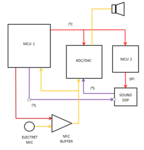Follow along with the video below to see how to install our site as a web app on your home screen.
Note: This feature may not be available in some browsers.

Your "hi res" circuit needs audio frequency response, low distortion and low noise. Audio opamps are made with those spec's. But you forgot to tell us what is the function of the circuit. A preamp to feed a power amp? A power amp to drive a speaker? Then the power amp also must have those spec's.
Hi,
I don´t see a preamp, nor a power amp.
What exactely do you refer to?
You ask about high resolution. Your didn´t specify "high resolution" and you don´t answer our other questions...
***
The sketch is almost digital... and at first sight i´d call it an overkill to use 3 processors. Why?
Klaus
This is meaningless as long as you don´t tell WHAT exactely you want to improve.and can improve quality for audio system
I don´t understand.Yes, for sure I need to use some of digital because that is the easiest way for me to control and increase the sampling frequency.
Again I have to disappoint you. I don´t know any device that may convert digital audio signals with 96kHz to analog with 24bit resolution on the analog side. In my eyes it´s more a marketing number.I want my device be able to play a 96KHz or above at 24-bit.
My opinion: Enigneering means to find out WHY it is distorted rather than build a new device. .. without specifying your expected system performance before.but when it plays a hi res music files, the output becomes distorted.
Specify and measure your device from input to output.That's why I'm asking which level should I measure to improve it?
, I want my device be able to play a 96KHz or above at 24-bit. Before this I made a audio circuit that using 24-bit ADC/DAC (about 90dB dynamic range) but when it plays a hi res music files, the output becomes distorted.